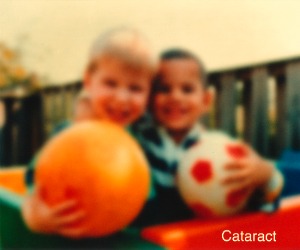 The eye’s clear lens plays an important role in
the remarkable process of sight. It focuses light—just like a camera’s
lens— on the light-sensitive tissue at the back of the eye. The lens
adjusts its focus, changing shape so that we can see things clearly both
up close and far away.
The eye’s clear lens plays an important role in
the remarkable process of sight. It focuses light—just like a camera’s
lens— on the light-sensitive tissue at the back of the eye. The lens
adjusts its focus, changing shape so that we can see things clearly both
up close and far away.Light is then transformed into nerve signals that travel to the brain, which interprets the light as an image, creating our experience of sight.
The lens is made up of protein and water. As we age, some of the protein may clump together and begin to cloud a small area of the lens. This is a cataract.
Cataracts are one of the leading causes of vision loss among American seniors. Worldwide, they are the number one cause of vision loss.
Seeing the World Through a Cataract
A cataract forms slowly and painlessly. In the beginning, it affects only a small area of the eye, and vision changes might not be noticeable. As it gradually progresses, the cataract grows larger. It clouds the lens and prevents it from focusing properly.
A cataract may change your vision in one of two ways:
- Eyesight becomes blurred, as though you were looking through a cloudy piece of glass or at an impressionist painting. Lights may seem too bright. Halos may appear around them.
- The lens takes on a yellowish-brownish color. This tinting does not affect the sharpness of the image, but makes colors seem faded. Night vision may be poor.
Vigorous exercise and healthy eating may help prevent vision loss.
Are You at Risk for Cataracts?
Your chances of developing a cataract increase as you get older. Other risk factors include being female, a family history of cataracts, eye inflammation or injury, surgery for another eye problem, hypertension, diabetes, smoking, long-term use of steroids, heavy alcohol use and prolonged exposure to the sun’s ultraviolet light.
A separate study of over 1,800 women ages 50 to 79 determined that those who followed nationally recommended dietary guidelines most closely had a 37 percent lower risk of cataracts.
Focus on Eye-Healthy Foods
Lutein and zeaxanthin: Brightly colored fruits and vegetables such as broccoli, spinach, kale, corn, green beans, peas, oranges and tangerines.
Essential fatty acids: Fatty fish such as tuna, salmon or herring, whole-grain foods, chicken and eggs.
Vitamin C: Fruits and vegetables, including oranges, grapefruit, strawberries, papaya, green peppers and tomatoes.
Vitamin E: Vegetable oils, almonds, pecans, sweet potatoes, sunflower seeds.
Zinc: Extra-lean red meat, poultry, liver, shellfish, milk, baked beans, whole grains
It’s long been known that ultraviolet (UV) radiation from the sun can harm eyes.
Read the original article on davisvision.com
If we feel that your eyes require further testing, we’ll gladly schedule you a full eye exam with our in-house optometrist. Please note there is a charge for this appointment. You are free to schedule an appointment with another optometrist if you wish.
20/20 Eyeglass Superstore is a family owned and operated business with locations throughout central Florida. We look forward to becoming your trusted source for everything related to eye care, glasses and contacts. Should you have any questions or comments, please feel free to contact us anytime.
No comments:
Post a Comment